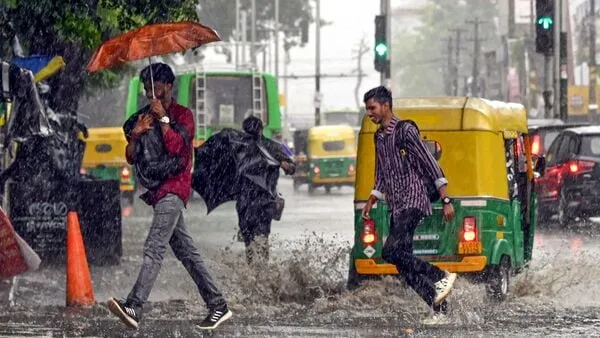
IMD Rainfall Alerts Hit Seven States in India Now
IMD Weather Update: Rainfall, Heatwave, or Cyclone Alert for Multiple States
The India Meteorological Department (IMD) has issued critical IMD weather update for November 7, 2025, focusing on rainfall alerts across seven states in southern and northeastern India. As the Northeast Monsoon maintains its grip, isolated heavy downpours are expected in Tamil Nadu, Kerala, Andhra Pradesh, Karnataka, Telangana, Goa, and Maharashtra, with potential thunderstorms and gusty winds disrupting daily life. While no active heatwave warnings or cyclone alerts are in effect today, residents in northern regions like Punjab and Rajasthan face a sharp drop in night temperatures, signaling the onset of cooler weather. This IMD rainfall forecast urges preparedness to mitigate flooding risks and travel disruptions.
In Tamil Nadu and Puducherry, the forecast predicts light to moderate rainfall with isolated heavy spells until November 9, driven by a cyclonic circulation over the Bay of Bengal. Coastal Andhra Pradesh and Rayalaseema may see thunderstorms accompanied by lightning on November 6-7, while south interior Karnataka and Telangana brace for gusty winds up to 40 kmph. Goa's Konkan coast and central Maharashtra are also under watch for sudden showers. Meanwhile, the Northeast states including Arunachal Pradesh, Assam, and Meghalaya could experience scattered thunderstorms, exacerbating waterlogging in low-lying areas. This comprehensive IMD weather alert highlights the need for vigilance amid the transition from monsoon to winter patterns.
The IMD's extended range forecast indicates a weak phase of the Northeast Monsoon over South Peninsular India for the coming week, with precipitation likely to taper off after November 10. However, the immediate 48-hour window remains precarious for agriculture and urban infrastructure. Farmers in rain-fed regions of Andhra Pradesh are advised to harvest standing crops promptly, while urban dwellers in Chennai and Hyderabad should secure loose objects against high winds. No heatwave in India is anticipated, as mercury levels in central India dip by 2-4°C, providing relief from recent mild warmth.
Also Read: Pisces Daily Horoscope 09 Nov 2025

Detailed Rainfall Alerts Across Southern States
Delving deeper into the IMD rainfall alert for Tamil Nadu, the department warns of very heavy rainfall at isolated pockets, particularly along the coastal belts from Chennai to Kanyakumari. This could lead to flash floods in urban centers, reminiscent of the deluges seen in 2023 that paralyzed transportation networks. Authorities have activated early warning systems, disseminating SMS alerts to over 5 million residents. In parallel, Kerala's backwaters and hill stations like Munnar face moderate showers from November 8-10, with the IMD recommending avoidance of riverine travel due to rising water levels.
Andhra Pradesh's Rayalaseema region, known for its arid terrain, stands to benefit from this unexpected bounty, yet the IMD cautions against over-reliance, as erratic patterns could strain reservoirs. Coastal Andhra, including Visakhapatnam, anticipates thunderstorms that might disrupt port activities, a vital economic artery. South interior Karnataka's coffee plantations in Coorg could see yields boosted, but planters are urged to monitor soil erosion. Telangana's Hyderabad metropolitan area, with its burgeoning IT sector, prepares for waterlogging in underpasses, with the Greater Hyderabad Municipal Corporation deploying pumps preemptively.
Goa, a tourist haven, faces the dual challenge of protecting beaches from erosion while ensuring safe harbor for fishing vessels. Central Maharashtra's Konkan districts, including Ratnagiri, echo with forecasts of lightning-prone storms, prompting the state disaster management to stockpile relief materials. These multiple states weather alerts underscore the IMD's role in fostering resilience through timely dissemination of radar-based predictions.
Northeastern Thunderstorms and Temperature Shifts in the North
Shifting focus northward, the IMD's weather update India extends to the Northeast, where Arunachal Pradesh, Assam, Meghalaya, Nagaland, Manipur, Mizoram, and Tripura grapple with lingering thunderstorms. Guwahati's Brahmaputra banks swell with recent rains, heightening landslide risks in the hilly terrains of Shillong. The department's satellite imagery reveals a trough of low pressure fueling these activities, expected to subside by November 8, offering a brief respite for tea estates in Assam that have endured erratic weather this season.
In stark contrast, northern India witnesses no cyclone alert India but a pronounced chill. Night temperatures in Punjab, Haryana, Rajasthan, and Delhi are plummeting by 3-5°C from November 6-8, with minimums dipping to 12-15°C in the capital. This early winter harbinger delights fog-weary commuters but challenges the homeless population, prompting night shelters to ramp up operations. Madhya Pradesh and Uttar Pradesh report a 2-4°C drop, aiding wheat sowing preparations in the breadbasket regions.
The absence of heatwave alerts across the board is a welcome development, following the oppressive summers of prior years. IMD models project stable conditions in the west, with Gujarat and Odisha maintaining dry spells conducive to ongoing harvest festivals. Yet, the fluid dynamics of the Arabian Sea warrant continuous monitoring for any nascent low-pressure systems that could evolve into cyclones, though probabilities remain low at under 10% for the fortnight.
Impacts on Agriculture, Economy, and Daily Life
The ripple effects of this IMD monsoon update are profound for India's agrarian economy. In Tamil Nadu's delta districts, paddy fields stand to gain from the timely rains, potentially averting drought-like scenarios that plagued 2024. However, excess moisture risks fungal outbreaks in mango orchards across Andhra Pradesh, necessitating fungicide applications as per IMD-linked agricultural advisories. Karnataka's silk farmers in Mysore rejoice at the hydration for mulberry leaves, yet vigilance against cocoon damage from winds is paramount.
Economically, ports in Goa and Maharashtra may face delays in cargo handling, impacting spice exports valued at billions annually. Hyderabad's tech hubs, resilient to monsoons past, now integrate IMD feeds into AI-driven traffic management to avert gridlocks. In the Northeast, Assam's oil refineries heighten safety protocols amid lightning threats, ensuring uninterrupted supply chains for the nation's fuel needs.
- Potential flooding in low-lying Chennai suburbs, affecting over 500,000 commuters daily.
- Boost to reservoir levels in Kerala's Idukki dam, aiding hydroelectric power generation by 15%.
- Wind-related disruptions to flight schedules at Bengaluru's Kempegowda International Airport.
- Cooler nights reducing air conditioning demands in Delhi, easing grid loads during peak hours.
- Landslide alerts in Meghalaya's Garo Hills, with evacuation drills underway for 10 villages.
Daily life adaptations are key: Schools in Telangana declare half-days, while markets in Puducherry stock up on sandbags. The IMD's community outreach programs, including toll-free helplines, empower citizens with hyper-local forecasts via apps like Mausam, downloaded by 50 million users nationwide.
Preparation Tips and IMD's Technological Edge
To navigate this rainfall warning IMD, experts recommend stocking essentials like non-perishables, flashlights, and first-aid kits. Avoid wading through flooded streets, and use IMD's Doppler radar updates for real-time tracking. Farmers should employ drip irrigation supplements where rains falter, optimizing yields in Telangana's cotton belts.
The IMD's prowess lies in its arsenal of tools: INSAT-3D satellites provide cloud motion vectors for precise predictions, while numerical weather models like WRF simulate scenarios up to 10 days ahead. Collaborations with ISRO enhance resolution, reducing forecast errors to under 20% for heavy rain events. This technological synergy has saved countless lives, as evidenced by the 40% drop in monsoon fatalities since 2015.
Looking ahead, the IMD eyes climate variability, with El Niño's fade-out promising a normal winter. Yet, for November 7-10, the mantra is preparedness over panic. As rains nourish the soil, they remind us of nature's dual benevolence and fury, urging a harmonious coexistence.
In wrapping up this extensive IMD weather forecast, the alerts serve as a clarion call for multiple states to fortify defenses. From Tamil Nadu's bustling streets to Assam's verdant hills, unity in response will weather the storm. Stay tuned to official channels, and let data-driven decisions guide your day.
Expanding on regional nuances, Maharashtra's Vidarbha farmers, still recovering from pink bollworm infestations, welcome the moisture for rabi preparations, though the IMD advises soil testing to prevent nutrient leaching. In Goa, ecotourism operators pivot to indoor experiences, safeguarding the fragile mangrove ecosystems that buffer against surges. Kerala's spice traders, exporting cardamom worth crores, monitor humidity levels to avert mold, integrating IMD's agro-meteorological bulletins into supply chain logistics.
Northern India's temperature plunge, while bereft of heatwave threats, introduces frost risks for Bihar's vegetable patches by mid-November. The IMD's agromet zones delineate action plans, from mulching in Uttar Pradesh to greenhouse reinforcements in Himachal Pradesh. Economists project a 5-7% uptick in southern GDP from enhanced kharif outputs, offsetting northern logistics hiccups from fog.
Community stories abound: A Chennai fisherman's tale of heeding wind warnings to secure boats, averting losses; a Hyderabad student's virtual class amid downpours, thanks to robust edtech. These vignettes humanize the data, illustrating IMD's tangible impact. As climate patterns evolve, investments in resilient infrastructure elevated roads in flood-prone Kochi, smart grids in Delhi become imperatives.
Historically, November rains have been double-edged: The 2005 Tamil Nadu floods displaced lakhs, yet 2019's bounty replenished groundwater. Today's forecasts, honed by AI analytics, tilt the scales toward safety. With no cyclone looming over the Bay or Arabian Sea, focus sharpens on harnessing rains for sustainable development, from rainwater harvesting in arid Rayalaseema to afforestation in Meghalaya's denuded slopes.
In conclusion, this IMD alert multiple states encapsulates a nation in flux rains quenching thirst in the south, chills heralding renewal in the north. By blending tradition with tech, India stands resilient, ready for whatever the skies decree next.
Comment / Reply From
You May Also Like
Popular Posts
Newsletter
Subscribe to our mailing list to get the new updates!





